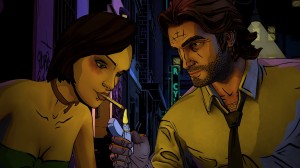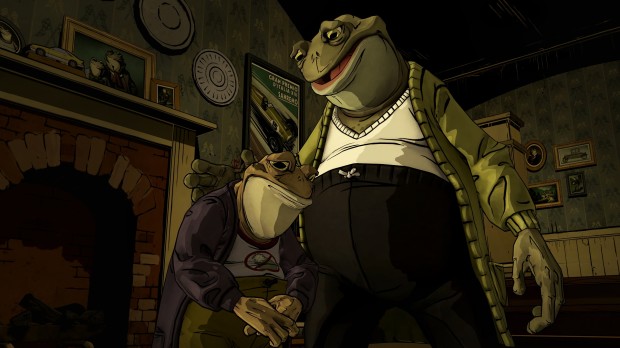The Wolf Among Us: Episode 1 – Faith Review
This game was reviewed on the PC.
Most games base a gamer’s skill on how quickly they can physically react in a coordinated fashion, or solve puzzles and mazes using critical thinking to reach an obvious goal. Some games even insert a personal element to them that affects the story, or even how characters in the game react to you, such as Mass Effect, or Dragon Age. The Wolf Among Us: Episode 1 – Faith does all of the above. Telltale Games brings us a graphical adventure that forces you to make social and critical thinking-based decisions with a very narrow window of time, and it also makes you react to physical assaults with keyboard (or controller) prompts that are sure to get your heart pounding. Let’s take a look at the first installment of this episodic marvel, and really dig into what you can expect when you play it.
Faith is the first in a five-part game series that revolves around a community based out of New York City called Fabletown. This community is home to Fables, who are fairy tale characters that had been exiled hundreds of years ago from their magical homelands. Sound familiar? It should. The popular television series Once Upon a Time has a similar premise, but don’t be fooled: the two stories are extremely different. If this were to be a television series similar to Once Upon a Time, it would be aired on HBO, not ABC.
In Fabletown, everybody remembers one another, and that they were exiled. They use a type of magic called Glamour to protect their true identities so they’ll look like normal human beings as well, making it an interesting sight to see when characters reveal their true form. Sherriff Bigby Wolf (also nicknamed “Big B”) is the main character in the story, and it’s up to players to determine if our protagonist is a true hero, or an antihero. We all know the story of the Big Bad Wolf and Little Red Riding Hood, but taking a look inside Big B’s real life makes you wonder just how much we really know about the tales and the characters from our youth.
 Much like any graphic adventure series, players will have the option to explore rooms using the left and right mouse buttons (on the PC), clicking on objects or people of interest as they seem fit. Quicktime events can be frequent, but much of the timing and aiming has enough leeway that players won’t be swearing at the controller or keyboard because they missed the target again. Where the game does seem a little annoying is when you’re attempting to investigate objects. If you click something and you’re partway across the scene, sometimes Big B will walk over towards something and get stuck, then wander around trying to find a way to it, get to it, and stop, almost like he forgot why he was there in the first place. Humorous as it can be clicking on an object two or three times, finding out the item isn’t even that important to the investigation or story may get on people’s nerves. It doesn’t actually break the game at all, but it breaks the immersion enough that in those instances, it reminds you it’s just a video game.
Much like any graphic adventure series, players will have the option to explore rooms using the left and right mouse buttons (on the PC), clicking on objects or people of interest as they seem fit. Quicktime events can be frequent, but much of the timing and aiming has enough leeway that players won’t be swearing at the controller or keyboard because they missed the target again. Where the game does seem a little annoying is when you’re attempting to investigate objects. If you click something and you’re partway across the scene, sometimes Big B will walk over towards something and get stuck, then wander around trying to find a way to it, get to it, and stop, almost like he forgot why he was there in the first place. Humorous as it can be clicking on an object two or three times, finding out the item isn’t even that important to the investigation or story may get on people’s nerves. It doesn’t actually break the game at all, but it breaks the immersion enough that in those instances, it reminds you it’s just a video game.
 One of the best parts of the game is the dialog, which allows for responses to conversations you find yourself in as the game progresses, and each interaction is as unique as the last. Every conversation seems fluid, and never feels out of place (such as an NPC was just put in your way to kill time). When it is your turn to respond in a conversation, you usually have four options to choose from. The catch to this is that you have a red meter that shrinks rapidly below your options, ensuring you choose your dialog quickly, but not usually giving you enough time to really think about how each choice may affect the story. If you don’t choose a dialog option, the game typically chooses the silence option, which can result in a loss of important information, confidence from another character, or worse. The choices are yours, but be prepared for the fallout. For example, when you are entering the mayor’s office (Ichabod Crane), and someone in line grumbles that you’re butting. If you choose to be a smart aleck and respond sarcastically to the random stranger, you get an icon on the top left of the screen saying “He’ll remember that” and you move on with your day. This has dire consequences later, but for gamers who aren’t used to each tiny interaction being of importance, many mistakes can be easily made just because you aren’t thinking ahead.
One of the best parts of the game is the dialog, which allows for responses to conversations you find yourself in as the game progresses, and each interaction is as unique as the last. Every conversation seems fluid, and never feels out of place (such as an NPC was just put in your way to kill time). When it is your turn to respond in a conversation, you usually have four options to choose from. The catch to this is that you have a red meter that shrinks rapidly below your options, ensuring you choose your dialog quickly, but not usually giving you enough time to really think about how each choice may affect the story. If you don’t choose a dialog option, the game typically chooses the silence option, which can result in a loss of important information, confidence from another character, or worse. The choices are yours, but be prepared for the fallout. For example, when you are entering the mayor’s office (Ichabod Crane), and someone in line grumbles that you’re butting. If you choose to be a smart aleck and respond sarcastically to the random stranger, you get an icon on the top left of the screen saying “He’ll remember that” and you move on with your day. This has dire consequences later, but for gamers who aren’t used to each tiny interaction being of importance, many mistakes can be easily made just because you aren’t thinking ahead.
Players will eventually find themselves overthinking situations in their head as they realize just how deep each character is, or creating their own dialog and commentary on what’s going on. It’s even sad when you realize how more pressing matters only slightly overshadow the desire to reach out and help fix some of the more heartbreaking situations other characters find themselves in. The game forces you to really be a part of the game, and creates an entire world that you can truly connect with. You actually care what happens to Big B, and the other characters in Fabletown, which is a rare treat to gamers that few games can actually offer.
For those of you who enjoy a good comic now and again, the art style will be very familiar. Faith feels like a 2.5D mix between Sin City and Dick Tracy. The dark shadowy lighting, the bold outlines on the animations, and the bright splashes of colour with a taxi cab or a smear of blood make this game pop during every scene. The characters themselves are drawn with a lot of detail, and their expressions capture exactly what the voice actors portray. In fact, the voice acting is surprisingly fitting for each of the characters you come across – especially Big B. He’s got a slightly gruff tone to him, with a gentler, silkier touch to his voice when the need arises. Each character’s design from every curve to every sound is wonderfully executed, and creates an immersion that’s very rare to find, especially in a game with a comic style art theme. The music itself is subtle, playing the typical electronic cop beats you’d hear on CSI or Rookie Blue, and even a tiny shrilled tone in the background during moments of panic. Much of the game will have the music blend into the background, setting an undertone but nothing more, which makes the game feel much more realistic.
When you complete Faith, it will show you a percentage of people who made the same choices as you, which adds a unique appeal as well. This is the kind of pure ‘choose your own adventure’ game that people will want to play more than once just to see how everything turns out in the end. Instead of dropping $60 in cash for a dice roll on a game that will keep your attention, why not buy a season pass to the episodic graphical adventure The Wolf Among Us? Or hey, if you’re unsure, you can buy the first episode for $4.99 and try out the Episode 1 – Faith for yourself!
About This Post

